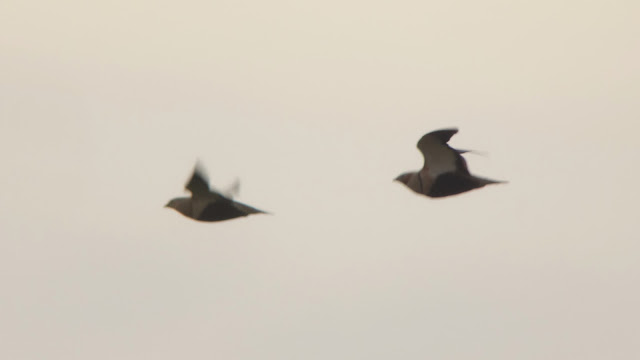Following a number of successful birding trips in the UK for
the last few years and with an increasing desire to explore to a wider scale,
plans were hatched in late 2016 for a short trip birding to the Iberian peninsula.
As one of my favourite European countries, it didn’t take a huge effort to be
on board for a group trip. Following some discussion, plans were formed looking
to explore the pseudo-steppe habitats in Extremadura, an area that I had not
previously visited, and with a small list of specialist species which I had not
seen to date. For the rest of the group however, it was the first time many of
them had ventured to the Iberian peninsula.
Our base for the week was located on a ridgeline overlooking
one of the best areas of Steppe in Extremadura on the edge of a picturesque
Mediterranean town, Sierra de Fuentes. Our accommodation proved to be very
lively for birds, with many of our ‘target’ species being seen from the balcony
of our accommodation!
One of our main reasons for our choice of accommodation was
due to its proximity to the Steppe habitats of the Santa Marta loop, well known
for its populations of many range restricted species.
The area is well known for its populations of both European
Bustard species, Great and Little, however both have declined significantly, as
mirrored across many areas of Iberia. However, both still exist in good numbers
in the ‘loop’, with many giving fairly good views from the tracks and roads
that cross their preferred habitat.
Great Bustard in
particular proved particularly easy to find, with one seen flapping its way heavily
over the motorway before we had even reached our accommodation for the first
time. Not a bad way to start the trip! Needless to say, with our proximity to
the Santa Marta loop, the species was seen on most days, with many sightings
from the motorways. When venturing onto
the plains, we often managed half decent views of the species, with good scope
views on many occasions. A few
displaying males were seen in full ‘bubble bath’ mode, gleaming white on the
short grass fields. Varying numbers were seen, with flocks of up to 25 noted,
but sightings of one, or a small number were much more common.
Little Bustard,
(almost in contrast) was fairly difficult to find. Although seen frequently
when birding the area, numbers were very low and we were often lucky to note
more than a couple at a time at a single location. Maybe due to their habit of
inhabiting longer grass areas they may have passed undetected, but few were
also heard calling their ‘raspberry’ like call. Small numbers were noted
throughout the trip though, and we managed a nice view of 1 male, displaying
from atop a rock near the road.
For me in particular, one of my main targets for the trip
were the 2 Sandgrouse species. Having previously visited areas with small,
fragmented populations of these species, I had missed them on previous trips.
However, we were well into their core range in Extremadura however they still
proved difficult to pin down. On our first morning we managed to hear both
species, but frustratingly could not locate the source of the sound. A number
of mimicking Calandra Larks did not
help the matter, with some remarkably similar sounds replicated in their songs
by at least 2 individuals in areas we checked regularly. An early morning trip
on the 13th to the area we had heard them previously finally
produced the goods. Following a number of calls being heard, 3 Sandgrouse flew
up quickly from behind a ridge. As they rose, we could hear them calling and
with a slight movement, revealed a large black patch on their belly. Black-Bellied Sandgrouse! They flew
straight towards the horizon, meaning only 2 of our group saw them before they
disappeared. While scanning the same small ridge, another familiar call could
be heard, Pin-tails! In a similar
fashion to the earlier Sandgrouse, up rose a large flock from behind the ridge of
Pin-tailed Sandgrouse, skimming low
across the plains. Following a short, circling flight, the flock dropped onto
the near side of the ridge, allowing us some distant, but very enjoyable views
of a flock of 17 Pin-tailed Sandgrouse!
Many other birds were seen over the course of the trip, and posts over the next week or so will show some of the highlights. of which there were many!





No comments:
Post a Comment